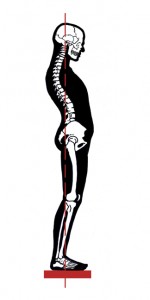 Our standing posture doesn’t always allow the body to breathe fully.
Our standing posture doesn’t always allow the body to breathe fully.
The diaphragm is the body’s primary muscle for breathing.
There are many other muscles involved but in a well-functioning body, the diaphragm is meant to descend slightly pulling air into the lungs like a vacuum.
When I write slightly I mean it—its movement can be measured in millimeters but a little goes a long way inside the body.
When the diaphragm descends it closes down the space of the abdominal cavity forcing the organs and the belly to move slightly forward.
This is the image of diaphragmatic, or belly, breathing—the belly moves out a bit on the inhale and retreats with the exhale.
Thoracic, or chest breathing, occurs when the diaphragm does not descend and the rib cage expands instead in order to make space for the lungs to increase in volume.
Diaphragmatic breathing is ideal but there are times, especially in yoga, when we might choose to breathe with the chest exclusively.
In the Ashtanga yoga practice the idea is to employ the bandhas—energetic locks- that tone the pelvic floor and the lower belly and then turn on the ujjayi breath, a specific type of breath used in yoga.
The ujjayi breath, which I love to use in practice, combined with the bandhas limits the breath to the chest and rib cage by choice.
People with poor posture—the majority of the world— tend to breathe into the chest because of the way they stand. When we stand with good posture the spine is a long pole with four very small curves. We need the curves of the spine for the body to work as designed but those curves should be as small as possible. The ideal curve is created by developing muscle tone to support the spine.
The main postural issue I see in the spine is a bit of a collapse that occurs where the middle, or thoracic spine, meets the lower, or lumbar spine.
At this juncture, the thoracic spine tends to lean back as the lumbar curves forward.
When this is the case, as in the picture above, the diaphragm will literally hit the spine on its descent and stop forcing the breath up into the chest.
The spine needs to be fully extended and the base of the rib cage— where the diaphragm is housed—needs to be level with the ground for the breath to work at its ideal best.
Aligning the spine and finding good postural balance frees the diaphragm and the breath to work at their best.
